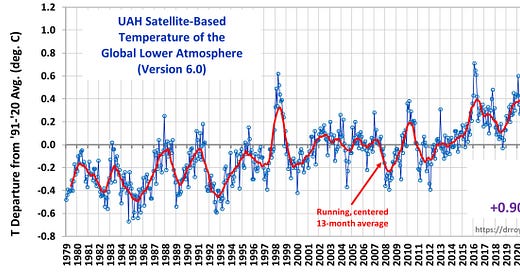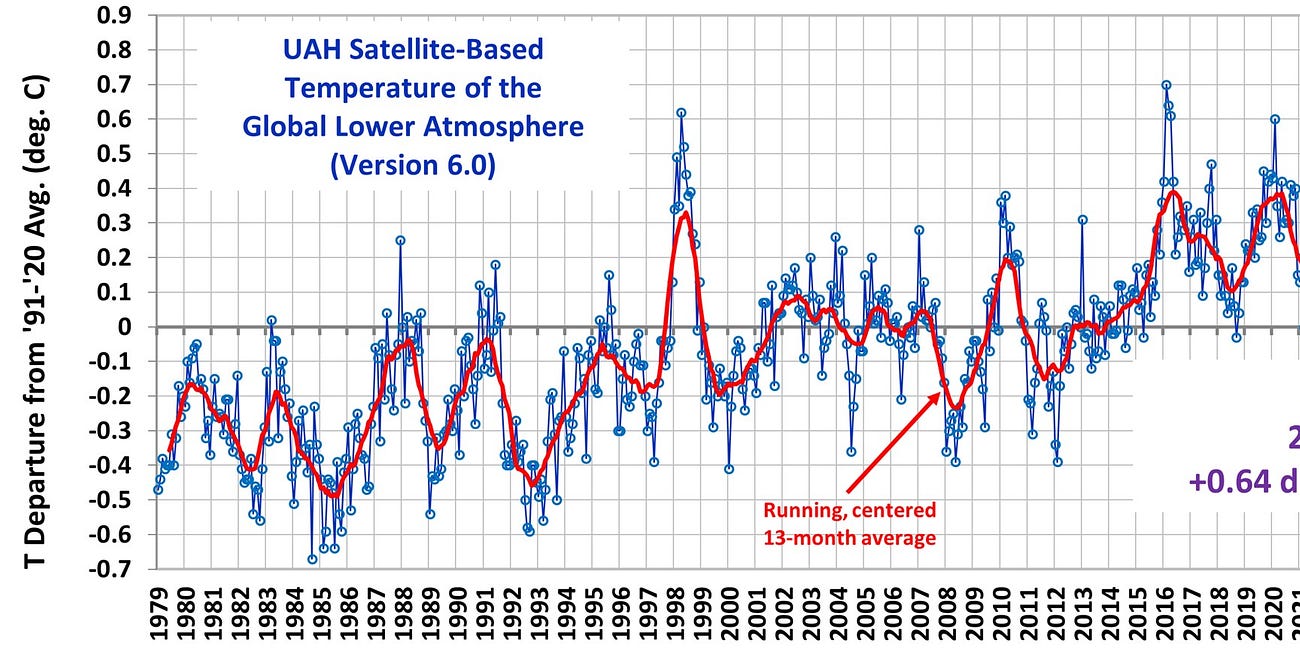Well here we are. This is the latest May 2024 UAH lower troposphere temperature anomaly.
Contrast and compare. Does 2023/24 warming spike look anything like other El Nino warming spikes (1983, 1988, 1998, 2010, 2016)? No! It doesn’t. We’ve got a cluster of ten very high temperature months which shows no sign of abating, even though May is down on the peak in April. Those high temperature months first started before El Nino warmth peaked, in fact when El Nino was just getting going, and now they are persisting long after temperatures in the critical central Pacific Nino 3.4 region have peaked. Here is the current situation and the latest ensemble forecast.
The 2023 warming spike was not caused by a ‘weird’ El Nino!
I said it wasn’t, even though prominent sceptics claimed it was, at the time.
The conclusion herein that Hunga Tonga is driving the current spike in global mean surface temperature is ‘controversial’. We have of course the usual suspects on the global warming side of the fence who are naturally eager to downplay the effects of Hunga Tonga on current global temperature, but even the more climate sceptical Dr Roy Spencer and Dr John Christy at the university of Alabama, Huntsville, are not giving credit to Hunga Tonga, preferring instead to point the finger of blame at the current modest developing El Nino:
The Science Of Hunga Tonga Global Warming - Part 1
None of this is ‘settled science’. A Hunga Tonga event hasn’t happened before - at least, it hasn’t happened where we can monitor in detail and in real time the ‘unprecedented’ injection and global distribution of water vapour into the stratosphere and analyse the subsequent effects on global temperature, atmospheric circulation patterns and stratospher…
Daily Sceptic Plugs El Nino As The Cause Of 2023 Global Warming Spike - Concedes Hunga Tonga May Have Had Something To Do With It
h/t Mark Hodgson This is the headline at the Daily Sceptic: That’s a statement of alleged fact. Chris Morrison backs up the headline statement by saying the following: Examine the latest global temperatures calculated by NASA and it can be seen that the recent months-long pattern of increasing anomalies is consistent with a similar rising record for the la…
Plenty of others, sceptics and climate alarmists alike, rushed to blame El Nino in the following months. They were wrong. The data now proves it. I called it in August 2023, pointing the finger of blame at Hunga Tonga. I might eventually be proven wrong, but it’s still the most likely explanation, even though sceptics in particular now seem to be jumping on the ‘ship fuels’ explanation, after quietly abandoning El Nino. What I said in August:
So here’s my suggestion: we are beginning to see rapid warming now, in summer 2023, because the radiative warming effect of the water vapour is no longer being cancelled by the aerosol cooling effect of Tonga. It’s as simple as that. On that basis, we can expect further warming over the next year or two and, with the possibility of a moderate El Nino developing in the central Pacific, that will add to the warming by the end of this year and we may be seeing a very significant rise in global temperature which of course the climate propagandists will attribute to anthropogenic greenhouse gases, so be warned; there could be much hysteria ahead, even the global declaration of a ‘climate emergency’.
Finally, we might expect to see changes in atmospheric circulation. So apart from generalised warming, extreme weather may become slightly more extreme in response to changing jet stream patterns. This has implications for rainfall, hot summers and possible severe winters.
It’s going to be a roller coaster couple of years methinks and the greatest threat we face will not be the weather or climate; it will come from those trying to exploit earth’s weather and climate for political and financial ends.
It's just occurred to me that underlying warming from the eruption of Hunga Tonga may have masked more than just cooling due to the emissions of stratospheric sulphate aerosols; it may also have cancelled cooling in 2022 due to the final year of the rare 'triple dip' La Nina. 2022 was in fact the warmest La Nina year ever recorded:
If this is so, then the warming as a result of the Hunga Tonga eruption may be even greater than estimated and now that the aerosols have disappeared AND El Nino is developing in the Pacific, we could be looking at some pretty extreme global warming in the next 6 months to a year. The media is going to go absolutely batshit crazy if so, even more so than they are at the moment.
Satellite Data Confirms July 2023 Was An Exceptionally Warm Month - Plus More On Why Tonga May Be The Cause
Dr Roy Spencer has updated the UAH lower tropospheric temperature series. The global temperature anomaly shot up to +0.64C in July: It’s almost as warm as February 2016 and just slightly warmer than April 1998, which marked the global warming peaks associated with two very powerful El Ninos. El Nino has barely got going at the present time so it can’t be…
The weather has been, and still is, quite exceptional in many parts of the globe, particularly rainfall. How does increased solar insolation from lack of sulphur aerosols in northern Atlantic shipping lanes explain this? As I pointed out in August 2023, the disruption caused to the upper atmospheric jet streams by the sudden injection of huge amounts of water vapour is expected to result in changes to regional and global circulation, leading to extreme weather events. That seems to me like a more likely explanation for the weather and the recent extraordinary global warming. A recent scientific study does indeed admit that Hunga Tonga may be affecting the weather, but pooh-poohs the idea that it was responsible for the rise in global temperature in 2023:
The Hunga Tonga Global Warming Con At The Con
h/t Doug Brodie The Conversation has today posted this article: Hunga Tonga-Hunga Ha’apai (Hunga Tonga for short) erupted on January 15 2022 in the Pacific Kingdom of Tonga. It created a tsunami which triggered warnings across the entire Pacific basin
The real cause of the extraordinary weather and climate events of 2023/24, currently ongoing, will eventually come to light. El Nino is now out of the reckoning. My guess is that cleaner ship fuels will eventually be ruled out. What does that leave? Hmmm.










10 deg C today in the Yorkshire Dales, at the beginning of June...
Yet the Met Orifice keep promising heat waves...
What are the physics of a sudden large spike of w/v at the Hunga Tonga level?
I don't know why folk don't think in terms of residence time. AFAICT there are only two ways to affect the energy content of a system in a radiation balance ( Atmosphere- Ocean - Land ) Either a change in input, or a change in the residence time of energy in the system.
Assuming steady state input ( which may not be accurate) then energy residence time is affected by a change in the materials encountered.
The oceans contain earth's longest residence time from solar input. Solar input residence time into the earth system varies from nano seconds due to albedo refraction, to decades, possibly centuries for some solar input into the oceans up to 800 feet deep.
The oceans contain approximately 1000 times the energy content of the Atmosphere. For instance, in the Southern hemisphere summer the solar input is up to 90 watts per meter greater then the Northern hemisphere summer. That is massive, at least 22 times greater then any possible affect from a CO2 increase of 130 PPM. ( 410 PPM vs 280 PPM pre industrial. )
Yet the Atmosphere cools despite this massive increase in solar radiation as a result of the earth being closer to the Sun. Why? The basic reason is that a large portion of said Southern Hemisphere summer increased insolation, inputs into the oceans below the surface, and SH summer increase falls on far more ocean then the NH summer, and, so that increased input is lost to the Atmosphere for a time. This, plus the increased albedo of the NH ( increased Snow Cover) reduces atmospheric residence time of said input.
Part of the point I am making is that a sudden spike in atmospheric temperature, means very little to the long term energy content of our earth's temperature. Does the earth's total energy content increase or decrease in the Southern Hemisphere summer? No one knows.
Yes, the atmospheric T cools, despite a massive increase in input, yet the ocean energy content increases significantly. In order to know if the earth's total energy ( land atmosphere and oceans) increased or decreased, and for what time period, one would have to know the amount of and residence time of increased solar insolation into the oceans during the SH summer. In order to know how much the oceans heat content increased, one would have to know the residence time of disparate solar W/L into the ocean. and the changes, not just in TSI, but the spectral solar changes which vary more than the TSI.
( We don't know this)
So, atmospheric increases or decreases mean little long term, as our oceans are the greatest reservoir of solar insolation energy. ( 1000 times greater) The Atmosphere is less than .1 percent of earth's energy content!
Thus traditionally the El Nino - LA Nina flux of energy from the oceans has the most rapid increase or decrease of atmospheric temperature. And the atmospheric flux means very little relative to earth's ( Land - Ocean - atmospheric) energy content. In general earth's total energy residence time is far longer for the oceans, far shorter for the Atmosphere, and in-between for the land.
As such, determining if the earth is gaining or losing energy by measuring just atmospheric T, is a bit of a fools errand. Yet here we are.
Now we have the Hunga Tonga input into the Atmosphere, and a very large W/V input into an area of the Atmosphere that traditionally has very little W/V! The increased residence time affect of any GHG exponentially declines as those GHG increase, due to saturation of said LWIR affected. And so a large increase of W/V into an atmospheric layer that is very dry, will have a larger affect then an increase into an already saturated atmospheric level. Additionally this affect is primarily atmospheric only. Also the absorbtion bands of W/V are far broader then CO2.
And so, the increased LWIR affect of Hunga Tonga, along with possible atmospheric circulation jet stream affects, could be cause to a short term (several years) spike in .1 percent of earth's atmospheric energy content, and yet mean little to nothing long term.
We can realistically eliminate CO2, as that LWIR affect is already saturated and each additional CO2 content increase has LESS affect. I agree we can eliminate El Nino, as we have a good history to evaluate that affect, and this spike does not reflect past atmospheric T response to ocean surface T flux.
So we have an atmospheric only response, which can be dramatic, but possible mean little long term.
I encourage thinking in energy residece time from a continues input. After all, even the proposed warming from GHGs is, in essence, and increase of residence time, as increased albedo is reduced residence time.
All the Best
DA.